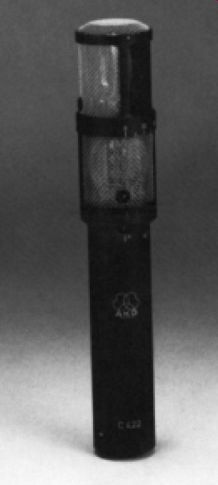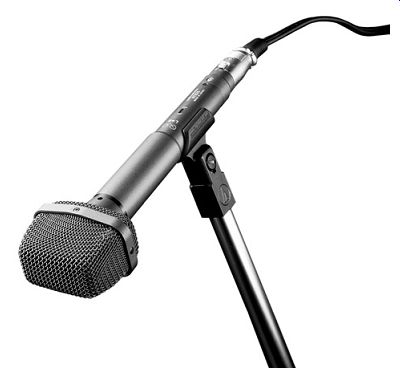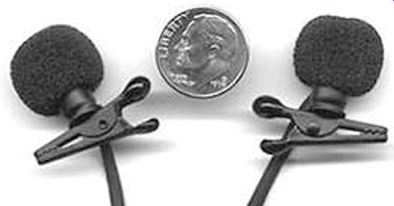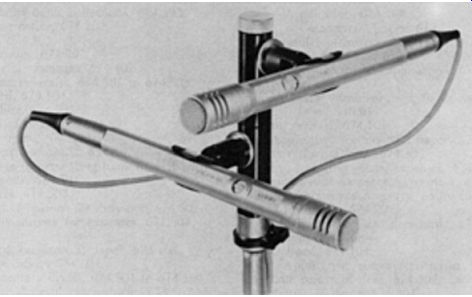This is a listing of stereo microphones, surround microphones, headworn mics, dummy heads, mid-side (MS) matrix boxes, and stereo microphone stand adapters. The list is up to date only for the date of publication of this guide. Since models and prices change, please contact the manufacturers for current information. This section is not a catalog of preferred products, but rather an illustration of currently available products and their features.
Note the following definitions of microphone specifications:
• Side-addressed: The axis of maximum sensitivity is at right angles to the microphone's long axis. You aim the side of the mic at the sound source.
• End-addressed: The axis of maximum sensitivity is the same as the mic's long axis. You aim the front of the mic at the sound source.
• Binaural: Two small mics are mounted flush with each ear canal. They pick up the "sound shadowing" effect of the head on the spectrum of the sound source (the frequency response and phase response of the head), plus the acoustic effects of the pinnae or outer ears.
• HRTF (head-related transfer function): Two small mics are mounted on the temples. They pick up the effect of the head on the spectrum of the sound source (the frequency response and phase response of the head), but not the effects of the pinnae.
Stereo Microphones
AKG C-426B Comb: Two twin-diaphragm condenser capsules, one atop the other, for MS or XY use. Three polar patterns with six intermediate steps. Low-cut switch, attenuator, and shock mount. Side-addressed. See FIG. 1.

FIG. 1
AKG C-426B Comb stereo microphone (AKG Acoustics, Inc.).
Audio-Technica AT822: End-addressed XY mic. Compact and light weight. Switchable low-frequency roll off, battery powered only, unbalanced outputs. Several accessories.
Audio-Technica AT825: Same as above but with battery or phantom power, balanced outputs, and flatter response. See FIG. 2.
Audio-Technica ATR25: End-addressed XY mic designed for video cameras. On-off switch. Several mounts and cables.
Audio-Technica Pro 24: Low-cost XY mic works on DC bias from recorder. End-addressed.
Beyerdynamic MC 833: Three large-diaphragm capsules with vari able positions. Works for MS or XY recording without an external matrix.
For orchestra/recital recording, ambience, and sampling. End-addressed.
Church Audio B-99M mini stereo mic and B-99A larger stereo mic:
Stealth headworn cardioid mics. All plug into a Church Audio mic preamp or stereo recorder with a stereo mini-phone input.
Core Sound Jecklin Disk (Optimal Stereo Signal (OSS) system): Padded baffle mount for two ear-spaced omni mics (FIG. 3).
Core Sound Schneider Disk: Has foam hemispheres covering the baffle.
Compared to the Jecklin Disk, offers slightly better approximation of binaural recording when played over headphones.

FIG. 2
Audio-Technica AT825 end-addressed XY mic (Audio Technica).

FIG. 3 Jecklin Disk (Josephson Engineering).

FIG. 4
Neumann USM69i stereo microphone (Neumann USA).

FIG. 5 Rode NT4 XY stereo microphone (Rode Microphones).
Crown SASS-PMKII Pressure Zone Microphone (PZM) Stereo Micro phone: Two ear-spaced PZMs on angled boundaries. For near-coincident, mono-compatible recording. End-addressed. See Figure C-3.
Josephson OSSD 1SK Jecklin Disk: Stereo mic baffle.
Josephson SPB: Spherical baffle for 21mm (0.8 in) microphones.
Neumann USM69i: Multi-pattern dual stereo MS/XY microphone.
Upper capsule can be rotated relative to the lower one through 270°. Side addressed. See FIG. 4.
Neumann KFM 100: A20 cm (7.8-inch) wooden sphere with two diametrically opposed pressure mics flush-mounted in the sphere. Time and spectral differences between channels produce the stereo imaging, with excellent depth reproduction. Response down to 10Hz. Side-addressed.
Pearl DS60: Two rectangular dual-membrane capsules mounted one above the other, 90° apart. For XY or MS methods. At your mixing console you can select the desired polar pattern and stereo system: cardioid, figure-eight, omni, XY, MS, or Blumlein. Phantom powered. Four XLR connectors. Side-addressed.
Pearl TL4/TL44: For mono or stereo use. Two discrete cardioid outputs may be used together or apart to get cardioid, omni, figure-eight, or 180° XY by adjusting your mixing-console controls. Phantom powered. Side-addressed.
Rode NT4: XY stereo microphone, battery or phantom powered (FIG. 5).
Royer SF-12: Stereo coincident ribbon microphone for Blumlein or MS technique.
Royer SF-24: Phantom-powered stereo ribbon microphone for Blumlein or MS technique.
Sanken CMS-7S: Portable MS mic. Requires external matrix box.
Fixed angle of polar patterns. CMS-7 has cardioid mid unit; CMS-7H has hypercardioid mid unit. End-addressed.
Sanken CMS-9: Portable MS mic similar to CMS-7, but with internal matrix so no external box is required. Left/right or MS outputs, fixed angle of polar patterns. End-addressed.
Sanken CUW-180: Adjustable XY microphone. End-addressed.
Schoeps KFM6 Sphere Microphone: Two omni capsules flush-mounted in an 8-inch wooden globe. Head-related phase and frequency compensation. Phantom powered. Side-addressed.
Schoeps KFM 360 Sphere Microphone: Smaller version of Schoeps KFM6 Sphere Microphone for surround use.
Schoeps MSTC 64G Office de Radiodiffusion Television Française or "ORTF" Microphone: Two MK 4 cardioid capsules at either end of a T-shaped dual-amplifier body, spaced 17 cm (6.7 inches) apart and angled 110°. XLR-5M output, 12-48V phantom powered.
Schoeps CMXY 4Vg: Two XY side-addressed cardioid CCM 4Vg capsules, interlocked so that they rotate in opposite directions to adjust stereo spread from 0° to 180°. Compact, with swivel base for hanging, boom mounting, or tabletop use. 12-48V phantom powered. Choice of connectors.
Two CMBI/MK or CMC/MK mics, with Schoeps accessories, can be set up for compact XY, MS, or near-coincident pickups.
Schoeps XY system: UMS 20 stereo bar with MK 4 capsules and CMC 6 microphone amplifier.
Schoeps Blumlein system: Two MK 8 capsules with stereo micro phone bar.
Schoeps MS system: AMS 22 elastic suspension for MS. Stereo micro phone bar UMS 20 with MK 8 and MK 4 or MK 41 microphone capsules and CMC 6 microphone amplifier.
Schoeps ORTF system: UMS 20 stereo bar with MK 4 capsules and CMC 6 microphone amplifier. Or STC stereo bar for ORTF with CCM 4 compact microphone or MK 4 microphone capsule plus KC cable and CMC microphone amplifier.
Shure VP88: MS mic with stereo or MS outputs. Switchable stereo spread control on microphone. Low-cut switch. End-addressed.
Sony ECM-DS70P: Mini stereo mic with two cardioid capsules back to-back. 1/8-inch (.317 cm) stereo phone plug built-in. 1-m (3.3-ft) detach able mic cable. Plug-in power operation. Response 100Hz-15 kHz.
Sony ECM-MS907: MS stereo mic with 1/8-inch stereo phone plug on 2-m (6.6-ft) cable. Battery powered. Adjustable stereo spread. Response 100Hz-15 kHz.
Sony ECM-MS957: MS stereo mic with 1/8-inch (.317 cm) stereo phone plug on 2-m (6.6-ft) cable. Battery powered. Adjustable stereo spread. Response 50Hz-18 kHz.
SoundField Microphones: See SoundField under the heading "Sur round Microphones" in this section.
The Sound Professionals offer a wide variety of stereo mics at different price/quality levels. For example, the SP-SPSM-6 is a premium hand held/stand stereo mic with cardioid or omni mic capsules on short boom arms. The SP-SPSM-3 is a small, T-shaped plug-in stereo mic. The SP-PSM3 is an MS stereo mic like the Sony ECM-MS907.
Studio Projects LSD2: Large-diaphragm stereo condenser mic. Rotatable capsules, switchable polar patterns, XY or MS, side-addressed.
T.H.E. Audio BS-3D sphere microphone for stereo and binaural recording. Two flush-mounted condenser mics in a head-size wooden sphere.
Many handheld flash-memory recorders come with built-in or plug in stereo microphones.
Surround Microphones
Holophone H2 Pro: Surround microphone captures up to 7.1 channels using an ellipsoid baffle with mic capsules. Discrete outputs; no matrix needed. See FIG. 6.
Holophone H3-D: Like the Holophone H2 Pro, but a less-expensive model with 5.1 channels.
Manley FLuRB processor for Mike Sokol's FLuRB Array: Sokol's mic technique uses four matched cardioid mics aiming front, left, right, and back in a coincident array. You plug the four mics into the Manley FLuRB matrix to get 5.1, 6.1, and 7.1 surround. The processor was in development when this guide was published.
Microtech Gefell INA 5: This array uses five shock-mounted M930 mics in the Ideal Cardioid Arrangement ( ICA 5, ITU-775 specification).
Schoeps Surround System: Includes KFM 360 Sphere Microphone, two CCM 8L figure-eight mics, and DSP-4 KFM 360 processor.
SoundField Microphone (ST250 or MKV): Uses four capsules arranged in a tetrahedron, phase-matrixed for true coincidence. Processor offers remote control of polar pattern, azimuth (horizontal rotation), elevation (vertical tilt), and dominance (fore/aft movement). AC or battery powered.
Provides stereo left/right, MS, mono or 4-channel B-format signals that can be matrixed into surround signals. Side-addressed. With flight case and 20-m (65.6 ft) cable.

FIG. 6 Holophone H2 Pro surround microphone (courtesy: Holophone).
SoundField 5.1 Microphone System: A single, multiple-capsule micro phone (SoundField ST250 or MKV) and SoundField Surround Decoder for recording in surround. The decoder translates the mic's B-format signals (X, Y, Z, and W) into L, C, R, LR, RR, and mono subwoofer outputs.
SoundField MKV Microphone System: Multi-capsule microphone and calibrated 2U processor provides mono, stereo, M/S, and surround. Controls Azimuth (Rotate), Elevation (Tilt), and Dominance (Zoom) and Solo each mic capsule. B-format outputs and inputs.
SoundField SPS422: Less-expensive SoundField model. Two forward facing capsules (left-front and right-front) and two backward-facing capsules (left-back and right-back). Processor offers remote control of pattern and width.
SoundField SPS422B Microphone System: Multi-capsule microphone and calibrated 1U processor provides mono, stereo, M/S, and surround.
Adjustable mic parameters include Gain, End Fire, Invert, High-Pass, Polar Patterns, Stereo Width, and Headphone monitoring.
SoundField SP451 Surround Sound Processor: Rackmount device sends surround sound directly to digital recorders "live" as the performance takes place. In post, it outputs a 5.1 surround mix and stereo mix from a pre-recorded B-format program. Creates up to three surround mic arrays with various polar patterns. Has B-format inputs (W, X, Y, and Z) and eight surround outputs.
SoundField ST350 Portable Microphone System: Multi-capsule micro phone and mic preamp/controller provides surround and stereo line-level signals. AC or battery powered.
SoundField Surround Zone: Digital audio workstation (DAW) plug in has the features of both the SP451 Surround Processor and MKV System.
Accepts B-format signals from any of the SoundField microphone models.
SPL Atmos 5.1 Surround Miking System, Model 9843: A system composed of the Atmos 5.1 Controller and the Brauner ASM 5 Adjustable Sur round Microphone. The controller includes high-quality mic preamps with a master gain control, a surround panning matrix, subchannel and low-frequency effect (LFE), stereo in/out, polar-pattern control, stereo spread control, and 6-channel monitoring. The microphone array has five matched Brauner VM 1 mics mounted 17.5 cm (6.9 in) from the center in the ICA( ICA 5, ITU-775 specification).
Dummy Heads and Headworn Binaural Mics
Head Acoustics model HMS III: Dummy head with omni measurement microphones. A record processor equalizes the head signals to have flat response in a frontal free field. A reproduce unit contains free-field equalizers for use with Stax SR-Lambda Professional headphones. Also available for recording is a unit with Schoeps capsules, two XLR-type outputs, and switchable equalization (EQ) for a frontal free field or random-incidence SoundField.
AM3D Valdemar dummy head. Two flush-mounted mics in pinnae. Includes torso.

FIG. 7 Core Sound CSB1 binaural microphones (courtesy: Core Sound).
Bruel & Kjaer 4100 Head and Torso Simulator: Uses two B&K mic capsules in a detailed replica of a human head and torso.
Church Audio binaural mics: Mics powered by a battery box or DC bias from a recorder or mic preamp. Church Audio's 1/2-inch mics cost less than their smaller "stealth" mics. They also offer an ST-20A battery powered mic preamp with a stereo mini-phone input and output.
Core Sound binaural mics: A variety of binaural microphone sets that you wear on your head (FIG. 7). Omni or cardioid capsules.
Powered by a battery box or DC bias (plug-in power) from a recorder.
High-end models use DPA4060/4061 capsules. Stealthy Cardioid set uses cardioid capsules to reduce pickup of room acoustics.
Sennheiser binaural mics sold by Microphone Madness: A number of binaural microphones such as the MM-HLSC-2 cardioid model and the MM-BSM-9 omni model.
Neumann KU 100 "Fritz III" dummy head binaural system: A detailed human-head replica with omni microphones inside the ears. Loudspeaker compatible. For music recording, radio drama, film special effects, outdoor nature recordings, acoustic evaluation, and scientific research. Powered by internal batteries or external phantom-power supply. See FIG. 8.
Sonic Studios Dimensional Stereo Mics (DSM): Unlike binaural mics, which are worn in the ears, DSM mics are two mini omni condenser mics meant to be worn on your temples (just forward of the ears). They are based on HRTF operation rather than binaural operation. DSM mics are said to provide more realistic sound over loudspeakers than binaural mics. Products include: DSM headworn mics, DSM HRTF baffle-mounted mics, DSM-15/x and 66/x stereo headworn mic, and 4-channel surround DSM mic system. Although they are normally headworn, DSM mics can be mounted on the Sonic Studios GUY or LiteGUY HRTF baffles, which are something like a dummy head but made of absorbent Sorbothane.
Soundman OKM binaural mics and OKM dummy head.
T.H.E. Audio BS-3D Sphere Microphone for stereo and binaural recording. Two flush-mounted condenser mics in a head-size wooden sphere.

FIG. 8 Neumann KU 100 dummy head (courtesy: Neumann USA).
Stereo and Surround Microphone Adapters
Audio Engineering Associates (AEA) Stereo Microphone Positioner (SMP) (FIG. 9): Positions coincident and near-coincident arrays. Handles large mics, such as Coles 4038. Vertical or horizontal arrays, stand mounted or hung. Rotation angles are lines engraved at +/-30°, 45°, and 55°. Center to-center spacing is marked on a ruler with ORTF position shown. Various lengths available.
AEA SMT4038: Stereo template and bar.

FIG. 9
AEA SMP (AEA).
AEA Tree Series: Mini-Tree, Decca Tree, and Super Tree. These multiple-microphone array mounts are used to securely position heavy microphones. The AEA modular microphone array can be configured to hold microphones for 5.1-channel recording.
Audio-Technica AT 8450: Stereo Hanger for two ES933 mics.
Beyer MAV 802: XY/ORTF mount.
Bruel & Kjaer CXY4000: Adjustable linear stereo rail for XY, MS, near-coincident, or spaced-pair miking.
Danish Pro Audio UAO 836: Stereo bar with sliding mic holders for A-B stereo. DUA 0019 19mm (0.75 in) spacer allows XY and ORTF techniques.
Neumann DS 21 mt dual microphone mount: Can be used to combine two miniature microphones and two bent capsule-extension tubes into one fixed assembly for stereo recordings.
Neumann DS 120: Double mount with sliding mic-holder studs for XY/near-coincident miking.
Neumann DA-AK and DA-KM: Elastic suspension mounts for MS miking.
On-Stage MY-500 stereo microphone mount: Low-cost, non-sliding mic mounts for XY or ORTF.
Sabra Som ST2 stereo microphone mount: Sliding mic mounts for XY or ORTF.
Schoeps UMS 20: Universal stereo bracket with balljoint. Has two sliding, locking clamps on a crossbar, with detents set at the correct angles and positions for XY, MS, and ORTF. See FIG. 10.
Schoeps MAB 1000: AB and ORTF mounting bar.
Schoeps M100C: Miniature ORTF mounting bar for MK4 capsules.

FIG. 10 Schoeps UMS 20 stereo microphone adapter.
Schoeps STCg: ORTF T-bar with SG20, sets two cardioid capsules 17 cm (6.7 inches) apart and angled 110°.
Schoeps MS-BLM: Boundary-layer twin clamp for MS, mounts KC5 and MK8 on a BLM-3 plate.
Schoeps SGMSC: Mounting stud for MS setup of MK8 and MK +/-. With swivel, stand clamp, 3/8-inch adapter.
Schoeps AMSCI: Elastic suspension with swivel. Holds an MK cardioid and an MK figure-eight mic capsule parallel for MS pickup.
Shure A27M: Uses two rotating stacked cylinders. Lets you adjust angle and spacing for coincident and near-coincident methods. See FIG. 11.
Sound Professionals SP-DTS-12: Mic mount for XY and ORTF. Contains non-sliding studs for mic holders.
MS Matrix Decoders
Groove Tubes MS Stereo Matrix Line Encoder: Encodes mid and side line level signals into left and right signals. Balanced or unbalanced.
Schoeps VMS 5U: Stereo mic preamp with phantom power and MS matrix. Low-cut filter, balanced I/O, battery or external DC power.
SoundField: The SoundField Microphone systems described under "Surround Microphones" include MS decoders.

FIG. 11 Shure A27M stereo microphone adapter (courtesy: Shure, Inc.).
Company Websites
AKG Acoustics US
akgusa.com
AM3D
am3d.com
Audio Engineering Associates (AEA)
wesdooley.com
Audio Technica US Inc.
audio-technica.com
Beyerdynamic Inc.
beyerdynamic.com
Bruel & Kjaer Instruments, Inc.
bkhome.com
Church Audio
church-audio.ca
Core Sound
core-sound.com
Crown International Inc.
crownaudio.com
Danish Pro Audio
dpamicrophones.com
Groove Tubes
groovetubes.com
HEAD Acoustics
head-acoustics.de
Holophone
holophone.com
Josephson Engineering
josephson.com
Manley Labs (FLuRB matrix)
manleylabs.com
Microphone Madness
microphonemadness.com
Microtech Gefell
microtechgefell.de
Neumann USA
neumannusa.com
On-Stage MY500 (various vendors, such as bhphotovideo.com)
Pearl Microphones AB
pearl.se
Rode Microphones
rode.com.au
Royer Microphone Labs
royerlabs.com
Sabra Som
sabra-som.com
Sanken Microphones
turneraudio.com
Schoeps Microphones
schoeps.de
Sennheiser Electronic Corp.
sennheiser.com
Shure Inc.
shure.com
Sonic Studios (DSM mics)
sonicstudios.com
Sony Professional Products
sony.com
SoundField Ltd.
soundfield.com
Soundman
soundman.de/englisch/english.htm
The Sound Professionals soundprofessionals.com
SPL (Atmos 5.1 system)
spl-usa.com
Studio Projects studioprojects.com
T.H.E. Audio theaudio.com